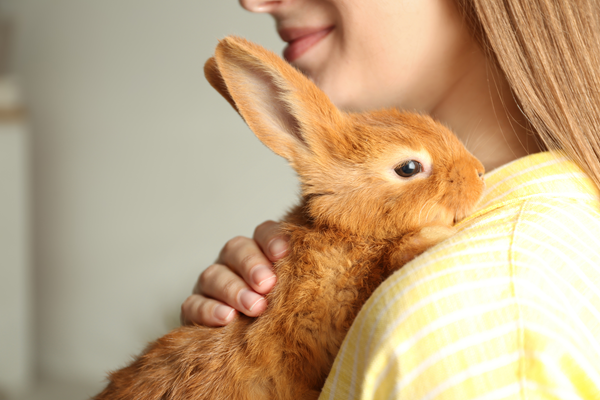
The official “Adopt a Rescued Rabbit Month” is past, but any time is a perfect time to consider bringing a furry, long-eared friend into your home. Rabbits make wonderful pets, but they require specific care to thrive. If you’re thinking about adopting a rabbit or are a new rabbit owner, this guide will help you understand what a rabbit needs for proper care and a happy, healthy life.
Understanding Rabbit Basics
Rabbits are social, intelligent, and curious creatures. They can live up to 10 years or more with proper care, and they thrive in an environment that meets their physical and emotional needs. Here’s what you need to know to provide the best care for your new bunny companion.
Housing and Space
Spacious Enclosure
- Size: Your rabbit’s enclosure should be large enough for them to move around comfortably. A minimum of 4-6 square feet of floor space per rabbit is recommended, but more space is always better.
- Bunny-proofed area: In addition to their enclosure, rabbits need a safe, bunny-proofed area to explore and exercise daily. This space should be free of electrical cords, toxic plants, and small objects they might chew on.
Comfortable bedding:
- Substate: Use rabbit-safe bedding material such as paper-based litter or straw. Avoid cedar or pine shavings as they can be harmful to rabbits.
- Hiding spots: Provide hiding spots within the enclosure, such as tunnels or hideaway boxes, to help your rabbit feel secure.
Diet and Nutrition
Fresh Hay
- Timothy hay: Hay should make up the bulk of your rabbit’s diet. Timothy hay is an excellent choice, providing essential fiber for their digestive health.
- Unlimited supply: Ensure your rabbit always has access to fresh hay.
Fresh Vegetables
- Variety: Offer a variety of fresh, leafy greens daily, such as romaine lettuce, carrot tops, and cilantro. Avoid iceberg lettuce, which has little nutritional value.
- Portion: Introduce new vegetables gradually and in moderation to avoid digestive upset.
Pellets
- Quality: Choose high-quality rabbit pellets that are high in fiber and low in protein and calcium. Pellets should be a supplement to hay and fresh vegetables, not the main part of the diet.
- Portion: Feed a limited amount of pellets based on your rabbit’s weight and age. Your veterinarian may recommend against pellets depending on your rabbit’s weight.
Fresh Water
- Constant access: Provide fresh water at all times, using a water bottle or a heavy ceramic bowl that can’t be easily tipped over.
Grooming and Health
Regular Grooming
- Brushing: Rabbits groom themselves but still benefit from regular brushing to remove loose fur and prevent hairballs, especially during shedding seasons.
- Nail trimming: Trim your rabbit’s nails regularly to prevent overgrowth and discomfort.
Health Checkups
- Veterinarian visits: Schedule regular checkups with a rabbit-savvy veterinarian starting right after you adopt your rabbit. Rabbits should have annual health exams to monitor their overall health and may need more frequent visits for dental care.
- Spaying/neutering: Spaying or neutering your rabbit is essential to prevent unwanted litters and reduce the risk of certain health issues.
Enrichment and Socialization
Mental Stimulation
- Toys: Provide a variety of toys to keep your rabbit mentally stimulated. Chew toys, cardboard boxes, and puzzle feeders are great options.
- Interactive time: Spend time interacting with your rabbit every day. Rabbits are social animals and thrive on attention and companionship.
Social Needs
- Bonding: Consider adopting a pair of rabbits, as they are social creatures that enjoy the company of other rabbits. Make sure to introduce them gradually and carefully.
- Handling: Handle your rabbit gently and calmly. Support their body properly to avoid injury, as rabbits have delicate spines. Rabbits can break their backs easily if they are mishandled or if they are startled and kick, so they are not a good choice for families with younger children. Rabbits should never be left unsupervised with small children.
Safe Environment
Indoor Living
- Indoors preferred: Rabbits are best kept indoors where they are safe from predators, extreme weather, and other hazards.
- Supervision: Always supervise your rabbit when they are outside of their enclosure to prevent accidents and ensure their safety.
Outdoor Time (Optional)
- Supervised outdoor play: If you choose to let your rabbit have outdoor time, ensure it’s in a secure, enclosed area free from potential threats. Supervise them at all times.
Adopting a rabbit is a rewarding experience that brings joy and companionship to both you and your new furry friend. By understanding and meeting your rabbit’s needs, you can ensure they live a happy, healthy life.
Do you have any tips for new rabbit owners or stories about your own rabbits? Share them in the comments below!




